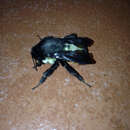tr
kırıntılardaki isimler


Bombus ephippiatus is a species of bumblebee native to Mexico and Central America.[1]
This is a variable species. There are a number of color polymorphisms, with body hairs in shades of white, yellow, orange, red, brown, and black.[2] Its species boundaries are not entirely clear. Some forms are similar to Bombus wilmattae, which may actually be the same species. There may also be some similar specimens in the area that are an as yet undescribed species.[1]
This bee feeds on many kinds of flowers. It is active year-round in some areas. It generally occupies pine-oak forest and other kinds of mountain forest habitat.[1] Its restriction to high-elevation regions may have produced physical isolation that led to its many color polymorphisms.[2]
It is an efficient pollinator of tomato plants.[3] The overcollection of queens from the wild for use in agricultural operations is a potential threat to the species.[1]
Bombus ephippiatus is a species of bumblebee native to Mexico and Central America.
This is a variable species. There are a number of color polymorphisms, with body hairs in shades of white, yellow, orange, red, brown, and black. Its species boundaries are not entirely clear. Some forms are similar to Bombus wilmattae, which may actually be the same species. There may also be some similar specimens in the area that are an as yet undescribed species.
This bee feeds on many kinds of flowers. It is active year-round in some areas. It generally occupies pine-oak forest and other kinds of mountain forest habitat. Its restriction to high-elevation regions may have produced physical isolation that led to its many color polymorphisms.
It is an efficient pollinator of tomato plants. The overcollection of queens from the wild for use in agricultural operations is a potential threat to the species.
Bombus ephippiatus is een vliesvleugelig insect uit de familie bijen en hommels (Apidae). De wetenschappelijke naam van de soort is voor het eerst geldig gepubliceerd in 1837 door Say.[1]
Bronnen, noten en/of referentiesBombus ephippiatus (saknar svenskt namn) är en insekt i överfamiljen bin (Apoidea) och släktet humlor (Bombus) som finns i södra Nordamerika och Centralamerika.
Bombus ephippiatus har en mycket växlande färgteckning, så växlande att det har framkastas att den kanske bör delas upp i flera underarter. Gemensamt för alla färgformerna är emellertid att de framtill på bakkroppen har ett stort, sadelformat område med blekt (i undantagsfall klargult) mittparti och klart färgade sidor i rött, orange, brunaktigt, blekgult och/eller svart (ephippiatus kommer av grekiskans ephippion, sadel). Andra och tredje bakkroppssegmenten (räknat framifrån) är antingen svarta eller röda (med undantag för det ljusa mittpartiet). Även mellankroppens sidor är klart färgade, medan ovandelen är svart hos arbetarna. De yttersta bakkroppssegmenten är vita.[3]
Humlan är en bergslevande art[4], som är en av de vanligaste humlorna i Mexiko och Centralamerika.[3] Som alla humlor lever den främst av nektar och pollen, men den har även iakttagits på as, fågelspillning samt mänsklig urin och avföring.[5]
Arten finns i södra Nordamerika och Centralamerika, från Mexico (delstaterna Chihuahua, Distrito Federal, Durango, Guanajuato, Hidalgo, México, Nuevo León, Querétaro de Arteaga, Zacatecas, Chiapas, Guerrero, Jalisco, Michoacán de Ocampo, Morelos, Nayarit, Oaxaca, Puebla, San Luis Potosi, Sinaloa, Tabasco och Veracruz), över Guatemala, El Salvador och Honduras till Costa Rica och Panama.[6] Uppgifter finns även att den skulle förekomma i Ecuador och Colombia.[3]
Bombus ephippiatus (saknar svenskt namn) är en insekt i överfamiljen bin (Apoidea) och släktet humlor (Bombus) som finns i södra Nordamerika och Centralamerika.
Bombus ephippiatus là một loài Hymenoptera trong họ Apidae. Loài này được Say mô tả khoa học năm 1837.[1]
Bombus ephippiatus là một loài Hymenoptera trong họ Apidae. Loài này được Say mô tả khoa học năm 1837.